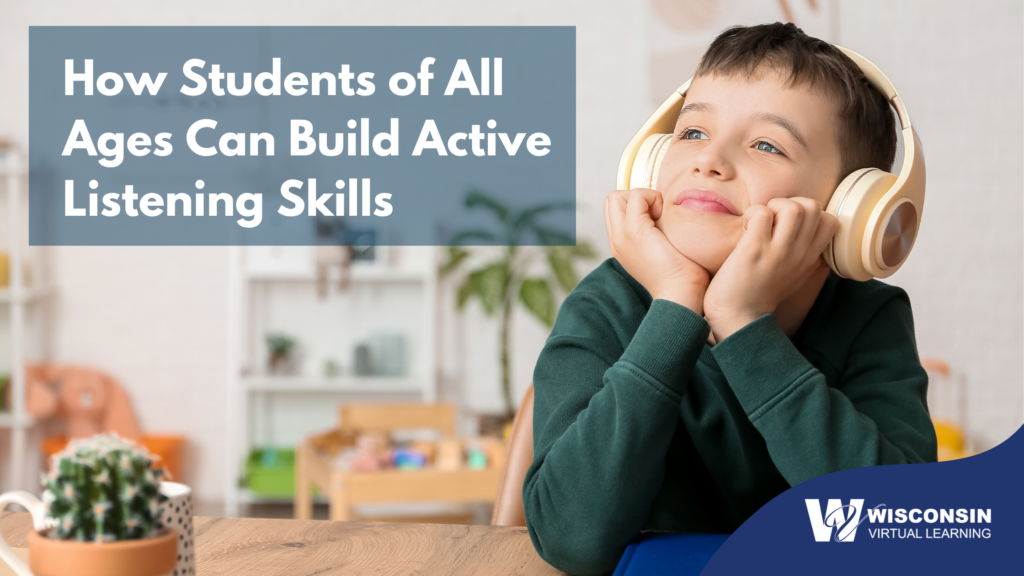As the parent or guardian of a student, you already know that it can be challenging to get children and teens to practice active listening. In a world full of digital distractions and real-life struggles, today’s young people need more than ever to master going beyond passive hearing. Active listening is a crucial skill that boosts learning and retention, is a vital part of communication, and enormously influences overall academic performance. For kids engaged in online education, these skills are even more essential.
What is Active Listening?
Active listening is more than just hearing the words someone says. It’s a dynamic process that requires fully engaging with the speaker, understanding their message, and responding thoughtfully. Imagine it as a two-way street where both speaker and listener are actively involved in creating a meaningful exchange.
When you actively listen, you go far beyond the surface level of words, deeper into the speaker’s intentions, feelings, and underlying message. To practice active listening, you have to be fully present in the moment, provide the speaker with your undivided attention, and show a genuine interest in what the other person has to say.
Techniques for Building Active Listening Skills
For Young Students (K-5)
- Interactive Story Sessions: Interactive storytelling keeps young learners engaged and interested. Pause frequently to ask questions about the story, encouraging your student to think and respond. Interactive story sessions enhance kids’ active listening skills and provide a sizeable boost to vital skills like critical thinking and comprehension.
- Use Visual Aids: Why not incorporate visual aids like pictures and videos to reinforce spoken words? Visuals help young learners better understand the material and stay engaged in the process.
- Games and Activities: Play is still vital for young students as they learn to interact with the world. Simple games like “Simon Says” or “Red Light, Green Light” teach children to listen carefully and follow instructions, making learning fun, interactive, and practical.
For Middle School Students (6-8)
- Group Discussions and Peer Activities: Encouraging your middle-school-aged learner to participate in group discussions is crucial, especially for virtual learners. At this age, group discussions in which students take turns listening and speaking help them practice active listening in a collaborative setting, further refining their social and communication skills.
- Role-Playing Exercises: There’s a reason role-playing exercises are used so widely in training and educational settings: they work! Use role-playing to simulate real-life scenarios with middle school learners. Not only do they help students learn to listen and formulate a situationally appropriate response, but they also foster empathy and compassion.
- Mindful Listening Exercises: Introduce mindful listening activities into the learning day, where students focus on different sounds in their environment or guided meditations that promote concentration and attention.
For High School Students (9-12)
- Encourage Note-Taking Strategies: While everyone has their own note-taking style, high school students must learn effective listening techniques actively and rapidly documenting key points. Treat note-taking like any other skill, and encourage high schoolers to review their notes to reinforce the material they’ve learned and to evaluate how their note-taking system is working for them.
- Critical Thinking and Discussion: Engage older students in debates and analytical discussions. These activities force students to listen carefully, evaluate different viewpoints, and articulate rebuttals.
- Reflective Practices: It’s always a good idea to encourage learners of any age to reflect on their listening experiences. Writing brief summaries or reflections on what they’ve heard promotes more profound understanding and greater retention.
Incorporating Active Listening in Online Learning
For students enrolled in online programs, active listening is especially crucial. Here are some tips for parents and guardians to support their learners:
- Create a Distraction-Free Environment: Your student’s learning space should be set up somewhere relatively quiet and free from household distractions so they can focus better during online classes.
- Use Online Tools and Resources: A mind-boggling array of online tools and resources can help students improve their active listening skills. For online learners, these resources include interactive lessons and recorded sessions, allowing students to review material and reinforce their understanding of the subject matter.
- Encourage Participation: It’s not always easy to get teenagers to participate in peer group activities, but doing so has an undeniable impact on listening comprehension and social skills.
Setting Your Online Learners Up for Active Listening Success
Active listening is a fundamental skill, one that students of all ages can develop to enhance their educational and life experiences. Wisconsin Virtual Learning prioritizes comprehensive skill development to ensure students are confident, equipped with essential life skills, and ready for the next step on their journey. Learn more about Wisconsin Virtual Learning, the program, and how it supports students in a fully accredited, fully online public school setting.

